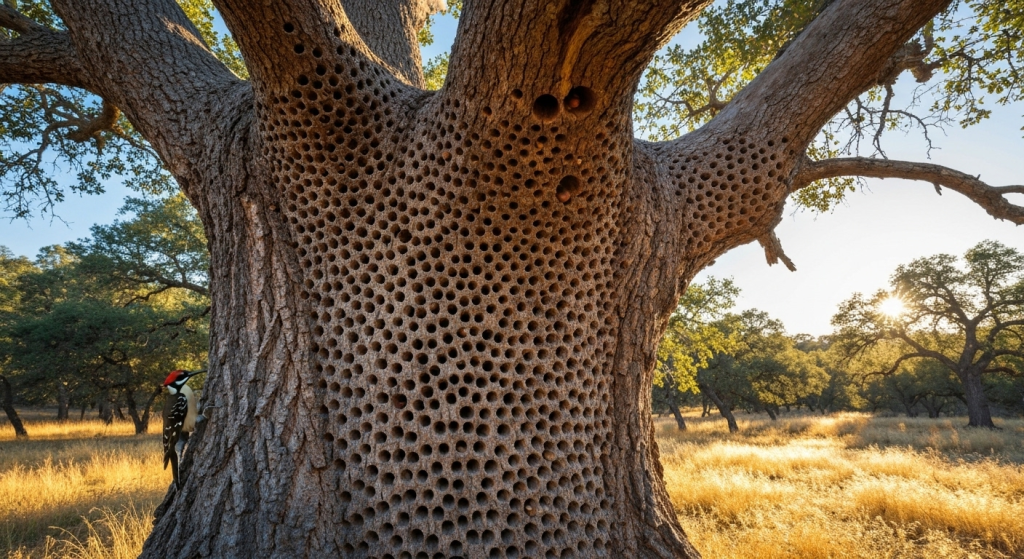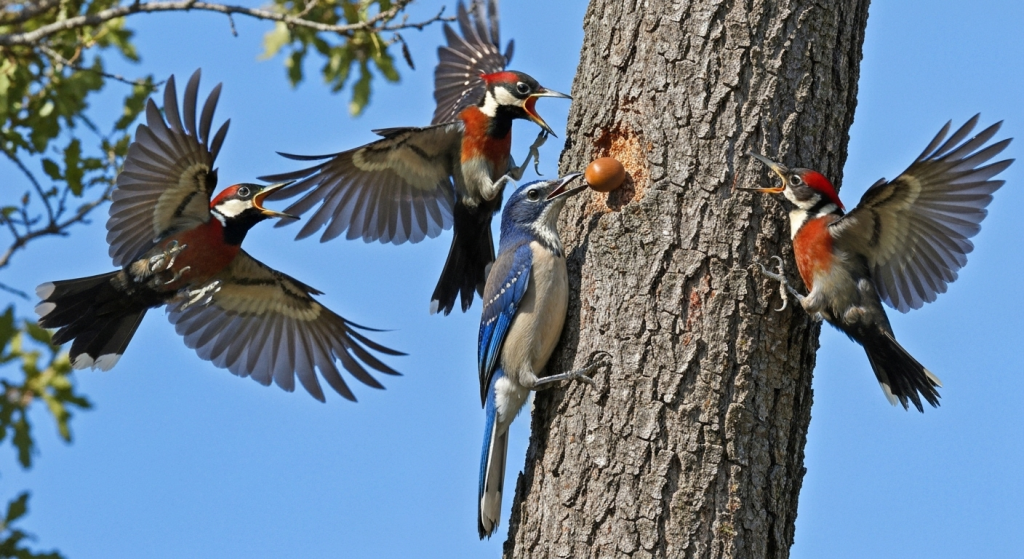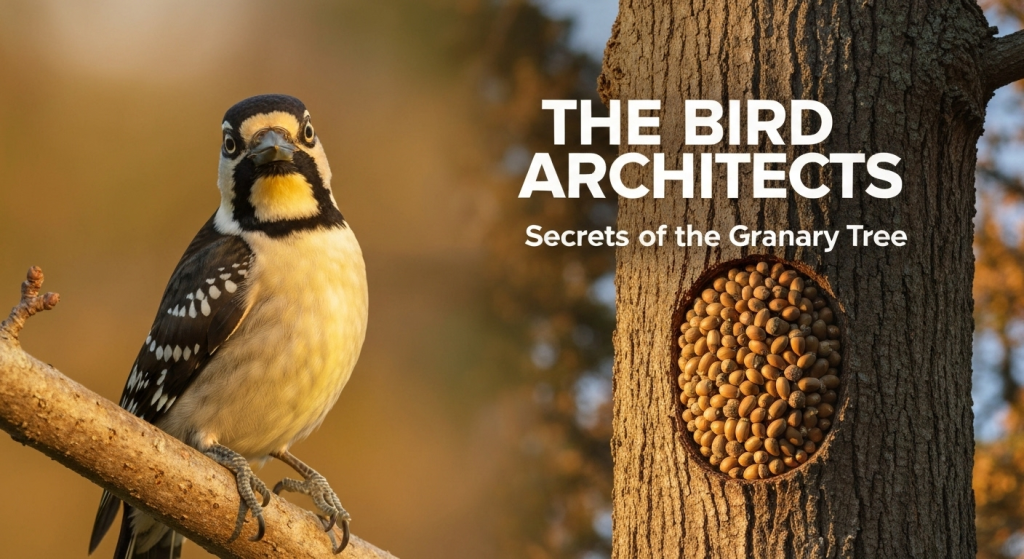If you’ve ever hiked through the oak woodlands of the American West, you might have stumbled upon a strange and wondrous sight: a tree trunk, often a dead snag or an old telephone pole, peppered with thousands of perfectly drilled holes. Each hole is meticulously plugged with a single acorn, creating a striking mosaic of nature’s ingenuity. This isn’t random art; it’s a masterpiece of survival engineering created by one of the most social and fascinating birds in North America—the Acorn Woodpecker. These structures, known as granary trees, are far more than just a place to store food. They are the center of a complex society, a treasure to be defended, and a legacy passed down through generations.
My fascination with bird behavior didn’t just come from books; it grew from countless hours spent in the field, observing the intricate lives of these creatures. As Mahnoor Farooq, I’ve dedicated years to exploring and writing about the diverse world of bird species, aiming to connect scientific research with the simple joy of understanding the “why” behind what we see in nature. My work isn’t about claiming to be a top expert, but about sharing the journey of discovery. The Acorn Woodpecker’s granary tree is a perfect example—a visual puzzle that, once you start to unravel it, reveals an incredible story of cooperation, strategy, and survival.
What is a Granary Tree? The Heart of the Colony

At its core, a granary tree is a communal food pantry. But unlike a squirrel that buries its nuts individually, Acorn Woodpeckers consolidate their resources into a single, highly organized, and fiercely protected location. This central larder is their insurance policy against the lean months of winter when insects and other food sources are scarce. A single granary can contain a few hundred acorns or, in the case of a well-established colony, an astonishing 50,000 acorns. This isn’t just a seasonal cache; it’s a permanent fixture that a family group can rely on for years, even decades.
These woodpeckers are not particularly picky about the tree itself, as long as it has a thick layer of dead wood or bark that’s easy to excavate. They often choose dead pines, oak snags, or even human-made structures like utility poles and wooden buildings. The key is that the wood must be dry, as drilling into live, sappy wood is much harder and the moisture could cause the stored acorns to rot. From my own observations in California’s oak savannas, it’s clear they select their granaries with purpose, often choosing a central location within their territory that is easy for the whole group to access and defend.
The Architects: A Look Inside the Acorn Woodpecker Society
You can’t understand the granary tree without understanding the birds who build it. Acorn Woodpeckers are anything but solitary. They live in complex family groups, or colonies, that function with a level of cooperation rarely seen in the avian world.
A Truly Cooperative Society
An Acorn Woodpecker colony typically includes one or two breeding males, a shared nest tended by one or more breeding females (often sisters), and several non-breeding “helpers.” These helpers are usually the offspring from previous seasons who stick around to assist the family. This system is known as cooperative breeding, and everyone has a job to do.
The workload is shared among all group members. This includes:
- Incubating eggs: Both breeders and helpers take turns sitting on the eggs.
- Feeding chicks: The entire family pitches in to bring food to the hungry nestlings.
- Territory defense: Protecting their valuable granary and nesting sites is a group effort.
- Granary maintenance: All members help drill new holes and manage the acorn supply.
This social structure is a powerful survival strategy. With more birds working together, the colony can gather more food, raise more young, and more effectively defend its resources than a single pair ever could.
A Family Legacy
The granary tree is the most valuable asset a colony possesses. It’s so crucial that territories are not defined by boundaries on a map, but by the granary tree itself. This resource is passed down from one generation to the next, much like a family inheritance. Young woodpeckers who stay on as helpers are essentially waiting for a chance to inherit the territory and become breeders themselves. A high-quality granary, packed with thousands of acorns, can ensure a family’s survival for generations. This makes the tree more than just a pantry; it’s the anchor of their entire existence.
The Art and Science of Storing Acorns

The process of creating and maintaining a granary is a year-round, labor-intensive task that showcases the woodpeckers’ remarkable foresight and adaptability. It’s a system honed by millions of years of evolution.
Drilling the Perfect Hole
When it’s time to store an acorn, a woodpecker doesn’t just find a random crack in the bark. It drills a custom hole perfectly sized for that specific acorn. The fit has to be just right—tight enough that a thief like a squirrel or a jay can’t easily pry it out, but not so tight that the woodpecker can’t remove it later.
But here’s the really clever part: as the stored acorns dry out over the fall and winter, they shrink. A once-perfect fit becomes loose, making the acorn vulnerable to theft and moisture. The woodpeckers constantly monitor their cache. I’ve watched them spend hours moving acorns from one hole to another, finding a new, smaller hole that provides a snugger fit for a shrunken acorn. This constant reshuffling is a critical part of their pantry management.
Preservation and Pest Control
The tight fit of the acorn in its hole is the primary method of preservation. It shields the nut from rain and snow, preventing mold and rot. It also makes it difficult for insects to lay their eggs in the acorn. By keeping the acorns dry and secure, the woodpeckers ensure their food supply remains viable throughout the winter. While they do eat insects found on the bark, the acorns are their primary source of carbohydrates, providing the energy they need to survive the cold.
To truly appreciate their strategy, it helps to see how it stacks up against other animals that rely on acorns.
| Feature | Acorn Woodpecker (Granary) | Gray Squirrel (Scatter-hoarding) |
| Storage Method | Centralized larder in a single tree or structure. | Acorns are buried one by one in many scattered locations. |
| Resource Visibility | Highly visible and requires constant, active group defense. | Hidden and relies on the individual’s spatial memory to recover. |
| Longevity | The granary is a permanent resource that can last for generations. | Many buried acorns are forgotten or stolen and are never recovered. |
| Social Aspect | A communal effort involving the entire family group. | A solitary effort performed by an individual for its own benefit. |
| Efficiency | High recovery rate since all food is in one place. | Lower recovery rate; forgotten acorns often sprout into new trees. |
Defending the Treasure: A Communal Effort
Owning a massive, visible stockpile of food in the middle of the woods means you’re always a target. Acorn Woodpeckers face a constant barrage of would-be thieves, and defending their granary is a top priority. Their primary competitors are Acorn Jays, squirrels, and even other woodpeckers who would rather steal than do the hard work of collecting their own acorns.
Their defense is loud, coordinated, and impressive to watch. When a threat is spotted, a sentinel lets out a sharp, rattling call—something like “waka-waka-waka”—that alerts the entire group. What follows is a unified response. The whole family will fly out to confront the intruder, mobbing and chasing it away from their territory. Over the years I’ve worked in these environments, I’ve seen a small family of five or six woodpeckers successfully drive off a much larger hawk. Their strength lies in their numbers and their shared commitment to protecting their life-sustaining pantry.
The Ecosystem Context: Life in the Oak Woodlands
Acorn Woodpeckers are inextricably linked to their habitat, primarily the oak and pine-oak woodlands of western North America. Their entire life cycle revolves around the seasonal production of acorns. Different oak species produce acorns at different times, and a healthy, diverse woodland provides a more reliable food source.
But their role extends beyond just being consumers. By drilling thousands of holes, they become “ecosystem engineers.” While they prefer dead wood, the cavities they create can eventually be used by other species for nesting or shelter, including bluebirds, titmice, and various insects. Though their primary goal is to store food, their actions inadvertently shape the habitat around them, creating new opportunities for other wildlife. This intricate connection highlights how the survival strategy of one species can ripple through an entire ecosystem.
Challenges in a Changing World
Despite their cleverness and social strength, Acorn Woodpeckers face significant threats in the modern era. Their specialized lifestyle makes them vulnerable to changes in their environment.
- Habitat Loss: The oak woodlands they depend on are shrinking due to urban development, agriculture, and altered fire regimes. Without a steady supply of acorns and suitable trees for granaries, their colonies cannot survive.
- Climate Change: Shifting climate patterns can disrupt the acorn production cycles of oak trees. A poor acorn crop, known as a “mast failure,” can be devastating for local woodpecker populations that rely on a surplus to get through the winter.
- Competition: Invasive species like European Starlings are aggressive competitors for nesting cavities. Starlings don’t build their own nests, so they often try to take over the cavities excavated by woodpeckers, putting further pressure on the Acorn Woodpeckers’ ability to breed successfully.
Frequently Asked Questions
Do Acorn Woodpeckers eat anything besides acorns?
Yes, absolutely. While acorns are their staple food for the winter, their diet is quite varied during the rest of the year. They are adept flycatchers, snatching insects out of the air, and they also eat fruit, flower nectar, and tree sap.
Do the holes they drill harm the tree?
Generally, no. Acorn Woodpeckers almost exclusively use dead trees or the dead limbs of live trees for their granaries. The bark and dry wood they drill into do not affect the living, vascular part of the tree. When they do use live trees, they stick to the thick, outer bark.
How long does it take to create a granary tree?
Creating a granary is a lifelong and multi-generational project. A new colony might start with a few dozen holes, but it takes many years of consistent work by the entire family to create a large granary with thousands of storage holes. The oldest and most impressive granaries are the work of many generations of woodpeckers.
Are Acorn Woodpeckers only found in California?
While they are an iconic bird of California’s oak woodlands, their range is much larger. They are found throughout Oregon, the Southwest United States, and down into Mexico and Central America, as far south as Colombia.
Conclusion
The Acorn Woodpecker’s granary tree is one of nature’s most compelling examples of strategy, cooperation, and foresight. It is far more than just a pantry; it is the cornerstone of their society, a fortress to be defended, and the key to their long-term survival. The sight of a tree studded with acorns is a powerful reminder that the natural world is filled with complex societies and ingenious solutions we are only just beginning to understand. Their story is a testament to the power of working together and a call to action to protect the beautiful, intricate woodland ecosystems they call home.


